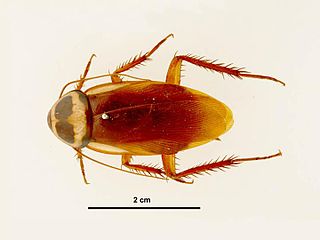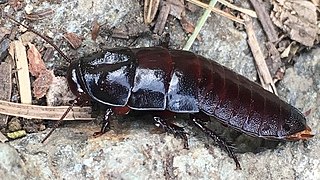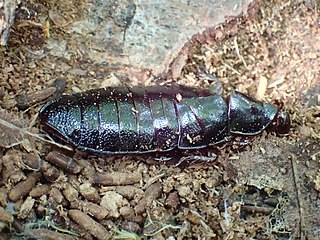
Cryptocercus is a genus of Dictyoptera and the sole member of its own family Cryptocercidae. Species are known as wood roaches or brown-hooded cockroaches. These roaches are subsocial, their young requiring considerable parental interaction. They also share wood-digesting gut bacteria types with wood-eating termites, and are therefore seen as evidence of a close genetic relationship, that termites are essentially evolved from social cockroaches.

The Australian cockroach is a common species of tropical cockroach, with a length of 23–35 mm (0.91–1.38 in). It is brown overall, with the tegmina having a conspicuous lateral pale stripe or margin, and the pronotum with a sharply contrasting pale or yellow margin. It is very similar in appearance to the American cockroach and may be easily mistaken for it. It is, however, slightly smaller than the American cockroach, and has a yellow margin on the thorax and yellow streaks at its sides near the wing base.

Parcoblatta virginica, the Virginia wood cockroach, is a small cockroach species of the genus Parcoblatta, measuring about a centimeter long as an adult.

Cryptocercus garciai is a species of wood roach named after American musician Jerry Garcia. It was discovered by Drs. Craig A. Burnside and Srinivas Kambhampati in 1998 in the Chattahoochee National Forest in northern Georgia. Prior to this, it was assumed that Cryptocercus punctulatus was the only species in the genus that existed in North America.

Therea petiveriana, variously called the desert cockroach, seven-spotted cockroach, or Indian domino cockroach, is a species of crepuscular cockroach found in southern India. They are members of a basal group within the cockroaches. This somewhat roundish and contrastingly marked cockroach is mainly found on the ground in scrub forest habitats where they may burrow under leaf litter or loose soil during the heat of the day.

Parcoblatta divisa, the southern wood cockroach, is a species of cockroach native to the United States.
Parcoblatta caudelli, Caudell's wood cockroach or Caudell's wood roach, is a species of cockroach native to the United States.

Plectoptera picta, the pictured beetle cockroach, is a species of cockroach in the family Ectobiidae. It is found in Central America and North America.

Blattoidea is a superfamily of cockroaches and termites in the order Blattodea. There are about 17 families and more than 4,100 described species in Blattoidea.
Triatoma recurva is a species of kissing bug in the family Reduviidae. It is found in Central America and North America. Like all of the kissing bugs in the genus Triatoma, it is an obligate blood feeder that primarily targets vertebrates. However, individuals can consume the hemolymph of arthropods, and can develop to maturity on a diet consisting entirely of cockroaches.
Pseudosaica florida is a species of assassin bug in the family Reduviidae. It is found in North America.
Pseudosaica is a genus of assassin bugs in the family Reduviidae. There are at least two described species in Pseudosaica.
Dasycorixa is a genus of water boatmen in the family Corixidae. There are at least three described species in Dasycorixa.
Arenivaga erratica, the erratic sand cockroach, is a species of cockroach in the family Corydiidae. It is found in Central America and North America.

Ischnoptera is a genus of cockroach in the family Ectobiidae.

Cryptocercus punctulatus, known generally as brown-hooded cockroach, is a species of cockroach in the family Cryptocercidae. Other common names include the woodroach, wingless wood roach, and eastern wood-eating cockroach. It is found in North America.
C. punctulatus is an oviparous cockroach in the family Cryptocercidae that excavates galleries in rotted wood. Field evidence suggests that pairs of C. punctulatus have a single reproductive episode during which they produce a mean of 73 eggs, in up to four oothecae. An extended period of brood care, which can last three years or longer, follows and includes defense of the family, gallery excavation, sanitation of the nest and, in the early stages, trophallactic feeding of the young. Nymphs are born without the cellulolytic protozoan symbionts they require to digest their wood diet; consequently, neonates rely on adults for nourishment... The altricial extreme of the developmental spectrum in cockroaches is currently represented by Cryptocercus punctulatus: this species hatches eyeless, with a pale, thin cuticle, is defended by parents in a nest, and is dependent on parents for symbionts and nourishment.
Coxelus serratus is a species of cylindrical bark beetle in the family Zopheridae. It is found in North America.
Curicta is a genus of waterscorpions in the family Nepidae native to freshwater habitats in the Americas. There are more than 15 species, with most restricted to South America. There are only two species in the United States: C. pronotata and C. scorpio.

Cryptocercus clevelandi is a species of cockroach in the family Cryptocercidae. It is found in North America.

Cryptocercus darwini is a species of cockroach in the family Cryptocercidae. It is found in North America.











